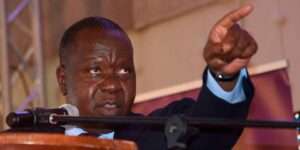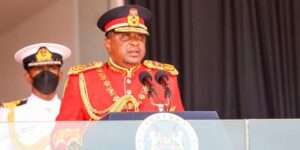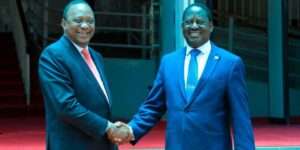Inside Uhuru Kenyatta State: Power and unwavering obedience.
As President Kenyatta presides over his last national day celebrations today, how he crafted a new administrative state will, perhaps, be one of the hallmarks of his last term. Held hostage during his first term by a political state, and afraid that he could be a lame duck in his last days in office, President Kenyatta reorganised the state to an extent that those who understand its inner workings say it will take many years to undo the Kenyatta II system.
The rise of an administrative and the collapse of the political states had casualties, the most noticeable being the falling out between President Kenyatta and Deputy President William Ruto, the emergence of Interior Cabinet Secretary Fred Matiang’i as a central figure in Mr Kenyatta’s second term, and the political truce between opposition leader Raila Odinga and President Kenyatta, which not only gave the latter some peace during his second term, but also some wiggle room to reconfigure the state.
Shifted his focus
Former Prime Minister Raila Odinga has become the greatest beneficiary of the arrangement and enjoys the backing of President Kenyatta, who eventually sidelined his deputy as his successor, much to the chagrin of those who support the political state.

Although the DP initially denied that he had been sidelined, he could only watch as President Kenyatta shifted his focus from politicians, which had a negative effect on the presidency, too. At first, and in public, President Kenyatta requested his deputy to halt early campaigns, but that request was swiftly ignored. And so, as Mr Kenyatta concentrated on restructuring the state—now interpreted by some quarters as the weakening of Ruto—he lost his power base of Mt Kenya as some of the politicians shifted their loyalty to the DP.
The second element of the rise of an administrative state has been the seconding of members of the disciplined forces to run various government entities. Here, the most noticeable was the establishment of the Nairobi Metropolitan Service under Lt-Gen Mohamed Badi, revitalisation of the Kenya Meat Commission, which is now run by the Kenya Defence Forces, and the appointment of various military officers to strategic institutions, such as Immigration.
The military also worked with the National Youth Service and the Kenya Railways to rebuild the Thika-Nanyuki metre-gauge railway, and have also built the new Lang’ata Road Museum of Heroes, where the Madaraka Day festival will be held today.
Though critics say President Kenyatta has used the military to tighten his grip on power, the truth is that it is part of the destruction of the political state. During his eighth State of the Nation address, the President justified his appointment of the military to run some state apparatus, arguing that he prefers them for their unity of command, efficiency and reasonable pricing.
But, on the political side, the loss of the Mt Kenya power base has been one of President Kenyatta’s biggest nightmares and various attempts to win back the support that he initially enjoyed have been an uphill task. As he tackled importation of illicit goods and fakes, President Kenyatta became unpopular with the business community, many of whom thrived on illegal activities. This was politicised—and as President Kenyatta kept away—the damage continued.

His close associates, who have organised meetings at the Sagana State Lodge to try and win back Mt Kenya, say he’s worried about this turn of events and the heavy price he had to pay for abandoning the political state, which survives on cronyism.
Mr Kenyatta found himself in this uncomfortable position thanks to a historical accident, or design, depending on whom you ask. As the first President to implement the 2010 Constitution, he had a first-term dilemma where the politicos held him hostage and his Cabinet secretaries were looked down upon by governors.
Apart from then Mombasa County Commissioner Nelson Marwa, most of the 47 commissioners agreed to play second fiddle in a system that gave preference to politicians, both on the political podium and in practice. The new devolved system of government also gave governors more muscle—and they would be saluted as “your excellency”, hitherto the preserve of the presidency. Also, the governors eclipsed Members of Parliament in terms of relevance and political hubris. After all, they held the meat and the knife.
In 1964, President Jomo Kenyatta built a strong provincial administration from the pillars left behind by the colonial government. Jomo inherited a colonial system that had given power to local chiefs and empowered the administrators, up the ranks, to maintain order within the state. While provincial and district commissioners became powerful, the Moi state at first maintained a balance but later opted to rebuild the ruling party, Kanu, and use its structures to control the state. Kanu, during Moi’s time, could not be questioned by Parliament or the Judiciary, and Moi said as much.
A political state
Thus, Moi’s reign was a political state, which explains the runaway corruption that became the hallmark of the Nyayo regime as political patronage was fuelled by sleaze, state capture and money laundering. While multi-party democracy after 1992 brought new challenges to single-party rule, with the opposition offering some checks and balances, the political state opened new avenues for sleaze, which included the grabbing of public land, sale of parastatals and reckless management of the economy.

The political state then operated with powerful regional kingpins and barons and was always on the lookout to co-opt new members as Kanu struggled to survive the post-Moi times.
That is how Mr Odinga found himself as Kanu secretary-general in the hope that he could use the Kanu structures to gain power. He didn’t, and his falling out with President Moi ended up benefiting the opposition, which was led by Mwai Kibaki.
Though President Kibaki had a chance to build an administrative state, it is interesting that he didn’t. Instead, during the first term, political infighting dominated as politicians bickered over the Memorandum of Understanding that he had reneged on.
Just like in the Moi era, some of the key figures of the Kibaki administration were caught up in political sleaze and an attempt to give the provincial administration some powers was thwarted.
This political state survived through President Kenyatta’s first term because most of his major projects were caught up in scandals in which he had become captive of the political state.
While there was noticeable camaraderie between him and his deputy, critics of the Jubilee administration voiced concern that the Uhuru state was turning into a citadel of sleaze. Most of the mega projects had become avenues of sleaze and his legacy was in limbo.
While he had effectively delivered on the standard gauge railway, which became one of Jubilee’s flagship projects, details that emerged later indicated that it was overpriced and the procurement of land had turned into a money minting project for the corrupt. The same also happened in the construction of dams, numerous energy projects, revamping of the National Youth Service and other infrastructure assignments. This was blamed on the powerful political state that gave President Kenyatta a reason—nay, an excuse—to dismantle the political structures that controlled the avenues of sleaze.
The best card on the table, his advisers thought, was to bring Mr Odinga on board and persuade him to back the war against corruption and help weaken the political structure, which relied on sleaze and crime. And so on March 9, 2018, in a surprise move that cooled tensions, both Mr Kenyatta and Mr Odinga abandoned their political hatred in a ceremonial handshake outside Harambee House in Nairobi in a move that redefined the Kenyatta succession, which was up to then seen as cut out for DP Ruto. Mr Odinga’s entry not only changed the political dynamics, but also allowed the DP to openly fight attempts to sideline him.
During the first term, President Kenyatta, his weaknesses notwithstanding, was overshadowed by the always-on-the-road deputy, whose touch with grassroots organisations and religious outfits mesmerised many.
War on corruption
By refusing to play politics, Kenyatta eclipsed himself and was seen as aloof, especially in Mt Kenya, where the DP laid down strategies to dismantle the Kenyatta networks.
To weaken the political state, President Kenyatta waged an open war on corruption and made changes within the security and administrative apparatus of the government. He also set loose state machinery to clamp down on financial structures that oiled the rogue political state.
Swift changes in the Directorate of Criminal Investigations were followed by others at the Office of the Director of Public Prosecutions and the Kenya Revenue Authority, which were now headed by career intelligence officers.
It appears that President Kenyatta’s decision to strike after he was re-elected was deliberate. As the DP said in a recent interview, the President told him he wanted to do things differently.
The most noticeable—though not as successful—has been the war on corruption, money laundering, gun-running, poaching, counterfeits and transnational crime.
The Judiciary had frustrated the war drug barons and cartels, forcing President Kenyatta to make an Executive decision that saw leading drug barons, the Akasha brothers, extradited to the US, where they pleaded guilty to trafficking. In Mombasa, Ibrahim and Baktash Akasha had managed to frustrate efforts by the state to extradite them.
However, it was the reorganisation of the administrative state and the appointment of Dr Matiang’i as the chairperson of the National Development Implementation and Communication Committee, which was mandated with supervising the execution of government programmes, that has been used to best illustrate the sidelining of the DP.
Previously, the DP moved around the country launching various projects and using them to lay the basis for his political future, much to the President’s chagrin.
Powers to supervise
In the Executive Order, whose import was not immediately seen, Dr Matiang’i was to guide a team of all Cabinet secretaries, Attorney-General Kihara Kariuki, and Head of Public Service Joseph Kinyua.
Another technical team, chaired by Interior Principal Secretary Karanja Kibicho, brought together all principal secretaries and gave them powers to supervise government projects, an indicator of the shift in power to the central administration.
Also established under the Executive Order were Regional and County Development Implementation Committees that were chaired by regional and county commissioners in their respective jurisdictions.
For the past five years, President Kenyatta has been implementing what is known as a “one government approach policy” through which the Ministry of Interior and Coordination of Government has been working with other ministries in the implementation of key government programmes.
Thus Dr Matiang’i and Dr Kibicho became the face of the Uhuru state. Whether this state will survive remains to be seen, but it has given him some peace as he navigates the last two months in office.
Credit: Source link